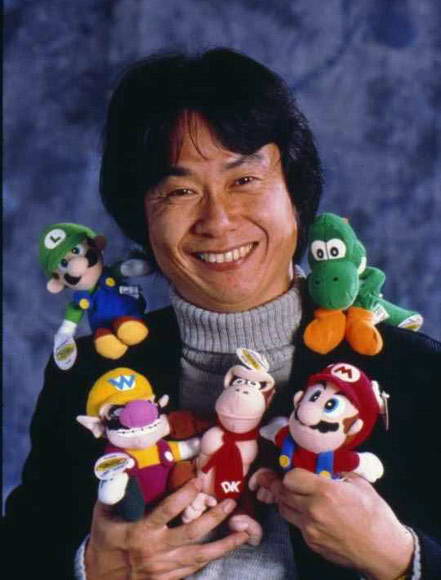Shigeru Miyamoto
Shigeru Miyamoto (宮本茂 Miyamoto Shigeru, born November 16, 1953)—sometimes known as Shiggy or Shigsy to fans—is the Japanese creator of Donkey Kong, Mario video games, the Legend of Zelda, and Pikmin series for Nintendo. He is one of the world's most celebrated game designers, and often called one of the fathers of the modern video game. His titles are characterised by refined control-mechanics and interactive worlds in which the players are encouraged to discover things for themselves, as well as basic storylines, which had been unheard of before he introduced the first one with Mario.
He is currently the Director and General Manager of Nintendo Entertainment Analysis and Development (EAD), the corporate sector of Nintendo of Japan. In 1998, Miyamoto became the first person to be inducted into the Academy of Interactive Arts and Sciences' Hall of Fame.
Employed by Nintendo (then a toy/playing card company) as an artist, in 1980 he was given the task of designing one of their first coin-op arcade games. The resulting title Donkey Kong was a huge success and the game's lead character, Jump Man, later renamed Mario has become Nintendo's mascot. Miyamoto quickly became Nintendo's star producer and built a large stable of franchises for the company, most of which are still active and very well-regarded.
Biography
Shigeru Miyamoto was born in Sonobe town, Kyoto, Japan. As a young boy, Miyamoto loved to draw, paint pictures, and explore the landscape surrounding his home. Stories describe his fascinated discovery of hidden caves, lakes, and other natural features that would influence his later work. In 1970, he enrolled in the Kanazawa Munici College of Industrial Arts and Crafts, and graduated five years later, though he would later remark that his studies often took a backseat to doodling. In 1977, Miyamoto, armed with a degree in industrial design, scored a meeting with Hiroshi Yamauchi — a friend of his father, and the head of Nintendo of Japan. Yamauchi hired Miyamoto to be a "staff artist", and assigned him to apprentice in the planning department.
In 1980, the fairly new American branch of Nintendo released Radar Scope, an arcade game they hoped would kickstart a long reign of success, but instead turned out to be a huge flop. To stay afloat, Nintendo of America desperately needed a smash-hit game. Hiroshi Yamauchi assigned Miyamoto — the only person available — the task of creating the game that would make or break the company.
After consulting with some of the company's engineers (Miyamoto had no prior programming experience), and composing the music himself on a small electronic keyboard, Donkey Kong was born.
Donkey Kong was an overnight success. Out of the three characters Miyamoto created for the game — Donkey Kong, Jump Man, and Pauline — Mario, a character who descends from Jump Man, has found the most success, and since his debut in Donkey Kong he has appeared in more than 100 games spanning over a dozen gaming platforms.
Miyamoto is usually listed as "producer" in the credits of Mario games. The few exceptions include the Super Mario Land series for the Game Boy, which he had virtually nothing to do with. In early US releases, he was sometimes credited as Miyahon—a misreading of the kanji in his name (本).
His influence can also be seen in the hardware realm of the gaming industry. These innovations that were shepherded by Miyamoto include the introduction of the L/R shoulder buttons (with the SNES) and the popularization of the analog control stick (with the Nintendo 64). While he didn't invent these, he was instrumental in popularizing them to the point where they have become standard in every game console.
Despite being an influential figure in video games and responsible for multi-million dollar franchises, Miyamoto is said to be very humble, insisting on being given an average income, and often rides a bike to work.
Miyamoto was the first member ever to be inducted into the AIAS Hall of Fame in 1998, an award that outlines his lifetime achievement and dramatic effect on the video game industry.
In March, 2005, Miyamoto was among the first honorees to receive a star on the Walk of Game, a section of San Francisco's Metreon Center that is modeled on Hollywood's Walk of Fame.
External links
- Miyamoto Shrine—A website dedicated to Shigeru Miyamoto
- Zelda Central—Fan site based on the Legend of Zelda series
- The Mushroom Kingdom—Fan site based on Super Mario
